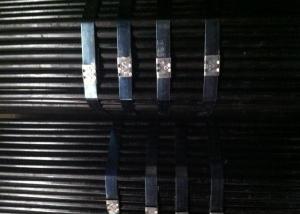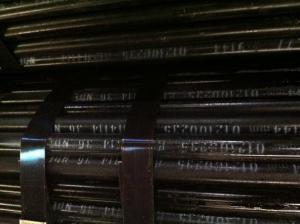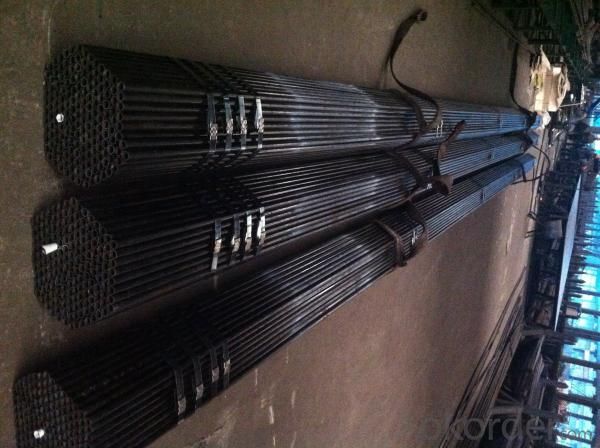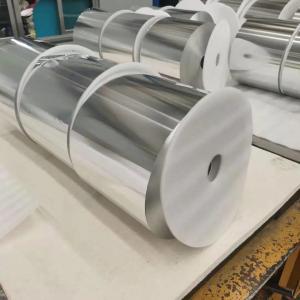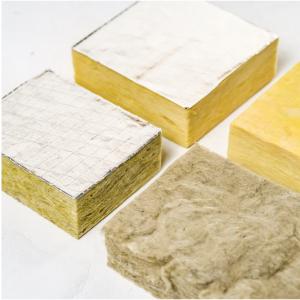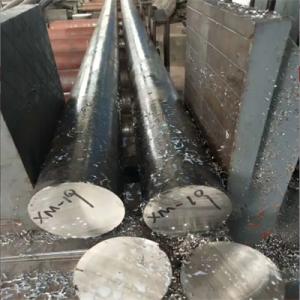Round High Temperature Seamless Carbon Steel Pipes
- Loading Port:
- China Main Port
- Payment Terms:
- TT or LC
- Min Order Qty:
- 20MT m.t.
- Supply Capability:
- 5000 Tons Per Month m.t./month
OKorder Service Pledge
OKorder Financial Service
You Might Also Like
Specifications of High Temperature Seamless Carbon Steel Pipe:
Standard : ASTM A106/ASME SA106
Main steel pipe grade : A106A 、 A106B 、 A 106C etc. (Other grade is also negotiable.)
Chemical Composition(%)&Mechanical Propertise :
Standard
Grade
Chemical Composition(%)
C Mn Si Cu Ni Cr Mo V P S
ASTMA106/ ASMESA106
Mechanical Propertise
Tensile Strength(Mpa)
Yield Strength(Mpa)
A
≥ 330
≥ 205
B
≥ 415
≥ 240
C
≥ 485
≥ 275
Usage/Applications:It is used for conveying water,petroleum,gas and other common fluids.
Packaging & Delivery:
Each bundles pipes will be bundled with 6-8 pcs steel strips and with shipping marks and 2 nylon strips
40-50 days delivery on china port upon receiving orinigal LC or prepayment.
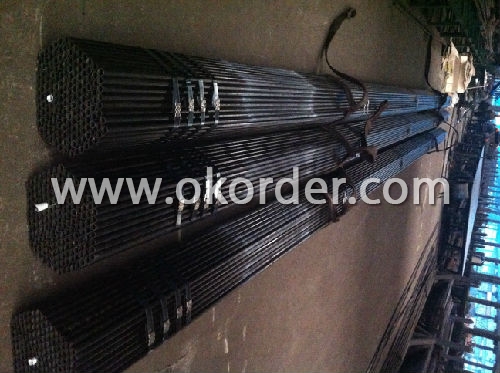
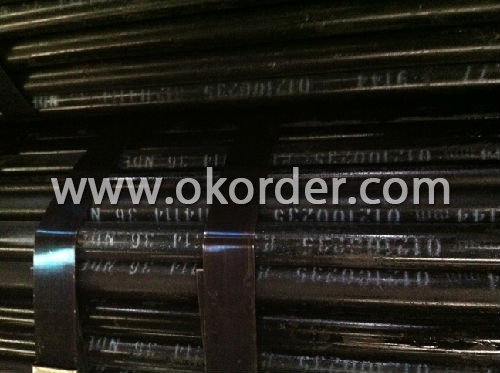
- Q:How are steel pipes used in the mining industry?
- Steel pipes are widely used in the mining industry for various purposes such as transporting water, slurry, and other fluids, as well as for ventilation and structural support in underground mines. Their durability, resistance to corrosion, and high pressure capacity make them ideal for these applications.
- Q:Are steel pipes resistant to fire?
- Yes, steel pipes are highly resistant to fire.
- Q:How do you calculate the pipe thermal expansion for steel pipes?
- To calculate the pipe thermal expansion for steel pipes, you need to consider the coefficient of thermal expansion (CTE) of the material, the temperature change, and the length of the pipe. The CTE is a measure of how much a material expands or contracts with temperature changes. For steel, the average CTE is typically around 12 x 10^-6 per degree Fahrenheit (or 6.5 x 10^-6 per degree Celsius). However, this value can vary depending on the specific grade of steel. Next, determine the temperature change that the pipe will experience. This can be the difference between the operating temperature and the ambient temperature, or the change in temperature due to the fluid or gas flowing through the pipe. Finally, calculate the thermal expansion using the formula: Thermal Expansion = CTE x Length x Temperature Change Where: - CTE is the coefficient of thermal expansion - Length is the length of the pipe - Temperature Change is the difference in temperature For example, if you have a steel pipe with a length of 10 meters (32.8 feet) and a temperature change of 100 degrees Celsius (180 degrees Fahrenheit), and assuming a CTE of 12 x 10^-6 per degree Celsius, the thermal expansion would be: Thermal Expansion = 12 x 10^-6 x 10 x 100 = 0.012 meters (or 12 millimeters) This means the pipe would expand by 12 millimeters due to the temperature change. It's important to note that this calculation provides an estimate of the thermal expansion, but other factors such as pipe supports, restraints, and the specific application should also be considered to ensure the proper design and installation of the steel pipe system.
- Q:What are the safety regulations for working with steel pipes?
- The safety regulations for working with steel pipes vary depending on the specific tasks involved, but some common regulations include wearing appropriate personal protective equipment (PPE) such as gloves, safety glasses, and steel-toed boots, ensuring proper ventilation in enclosed spaces, following proper lifting techniques to prevent back injuries, implementing proper fall protection measures when working at heights, and using caution when handling tools and equipment to prevent accidents and injuries. It is important to consult the relevant guidelines and regulations specific to your jurisdiction and industry to ensure compliance and promote a safe working environment.
- Q:Can steel pipes be used for geothermal applications?
- Yes, steel pipes can be used for geothermal applications. Steel pipes have high strength and durability, which makes them suitable for handling the high temperatures and pressures involved in geothermal systems. Additionally, steel pipes are resistant to corrosion and can withstand the harsh conditions found deep underground, making them a reliable choice for transporting geothermal fluids.
- Q:Can steel pipes be used for steam systems?
- Yes, steel pipes can be used for steam systems. Steel pipes are commonly used in steam systems due to their high strength, durability, and heat resistance properties. Additionally, steel pipes can withstand high pressures and temperatures, making them suitable for transporting steam safely and efficiently.
- Q:Can steel pipes be used for underground sprinkler systems?
- Yes, steel pipes can be used for underground sprinkler systems. However, it is important to note that steel pipes are not as commonly used as other materials like PVC or polyethylene due to their susceptibility to corrosion. If steel pipes are chosen for this application, they should be coated or lined to protect them from underground moisture and ensure their longevity.
- Q:How are steel pipes used in the construction of nuclear power plants?
- Steel pipes are used in the construction of nuclear power plants for various purposes, including transporting coolant, steam, and gases, as well as providing structural support for the overall system. These pipes are specifically designed to withstand high pressures, extreme temperatures, and corrosive environments, ensuring the safe and efficient operation of the nuclear power plant.
- Q:How can seamless steel tubes be produced?
- After extrusion to remove pipe sizing. The sizing machine passes through the cone bit and rotates into the steel embryo at high speed to form a steel tube. The inner diameter of the steel pipe is determined by the outside diameter and length of the sizing machine. When the steel tube is fixed, it enters the cooling tower and is cooled by spraying water. The steel tube is straightened after cooling. After straightening, the steel pipe is sent to the metal flaw detector (or water pressure experiment) by the conveyor belt for internal inspection. If there are cracks in the steel pipe, bubbles and other problems will be detected. Steel pipe quality inspection, but also through strict manual selection. After the quality inspection of the steel pipe, spray with the paint on the number, specifications, production batch number and so on. The crane is hoisted into the warehouse.
- Q:Can steel pipes be used for steam distribution?
- Yes, steel pipes can be used for steam distribution. Steel pipes are commonly used in steam distribution systems due to their high strength, durability, and resistance to high temperatures and pressure. They can effectively handle the transportation of steam in various industries such as power generation, chemical processing, and heating systems.
1. Manufacturer Overview |
|
|---|---|
| Location | Jiangsu, China |
| Year Established | 2005 |
| Annual Output Value | Above US$100 Million |
| Main Markets | Main land; Middle East; Southeast Asia |
| Company Certifications | ISO 9001:2008 |
2. Manufacturer Certificates |
|
|---|---|
| a) Certification Name | |
| Range | |
| Reference | |
| Validity Period | |
3. Manufacturer Capability |
|
|---|---|
| a)Trade Capacity | |
| Nearest Port | Shanghai |
| Export Percentage | 61% - 70% |
| No.of Employees in Trade Department | 390People |
| Language Spoken: | English; Chinese |
| b)Factory Information | |
| Factory Size: | Above 600,000 square meters |
| No. of Production Lines | Above 10 |
| Contract Manufacturing | OEM not offered |
| Product Price Range | Average |
Send your message to us
Round High Temperature Seamless Carbon Steel Pipes
- Loading Port:
- China Main Port
- Payment Terms:
- TT or LC
- Min Order Qty:
- 20MT m.t.
- Supply Capability:
- 5000 Tons Per Month m.t./month
OKorder Service Pledge
OKorder Financial Service
Similar products
New products
Hot products
Hot Searches
Related keywords
